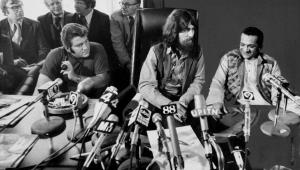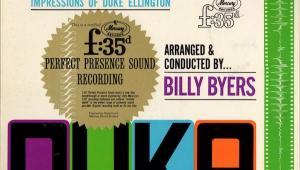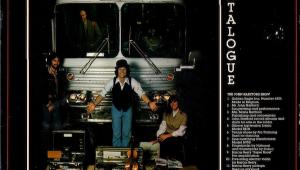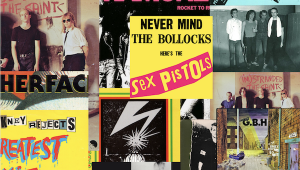Goin' Home: A Tribute to the Art of Tributes
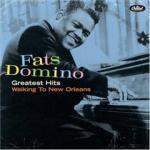
What’s not to love about Goin’ Home, the all-star tribute to New Orleans’ own Antoine “Fats” Domino, sweet-voiced and rhythmically inspired proponent of the Crescent City’s great R&B tradition?

Here’s Sir Paul McCartney, Sir Elton John, Blues Emperor B.B. King, Rock Prince Lenny Kravitz, Country Ambassador Willie Nelson, Indie Dauphine Tom Petty, Dutch Uncle Neil Young, and The Littlest Princess, Norah Jones – not to mention The Soweto Gospel Choir, The Skatalites, and Preservation Hall Jazz Band, all in back-up roles – among the nonstop cavalcade of super-celebrities reworking familiar and lesser-known nuggets from the voluminous catalogue of the second best-selling artist (behind the Big E, natch) in all of rock’n’roll history.
And don’t forget the same reclusive pianist and buoyant vocalist has now become the most visible, musically inclined poster child of The Great New Orleans Flood. Or that all proceeds from Goin’ Home will benefit Tipitina’s Foundation, the release’s producer and one of the most-visible music-related charities to emerge from the murky depths of the Crescent City’s hurricane-induced, broken-levee-released flood waters.
So What’s Not to Love?
Well, in my case, 17 tracks on the 30-track, two-CD release, to be precise (more than half the release). And you’ll likely have your own extended list of less-than-favorites.
So, what’s the point? None at all, if you live your life on the cutting edge of cultural change, where the CD has officially been proclaimed obsolete, random downloads are everything, and the shuffle has, in fact, become the message.
If, on the other hand, you’re mysteriously stuck back in the antiquated Dark Ages of linear aesthetic experienceyou know, plot lines, character development, song sequencing, that sort of thingwell, the point is, why bother?
Or if you’re one of those DIY aesthetic consumers (like myself), well, the point is you can probably find enough tracks you like to make it worth purchasing (or downloading) the two-CD set, then programming your own version.
Or, if you’re interested in the music of Fats Domino or in learning more about New Orleans’ great music heritage, or if you want to spend some money to help the city in its hour of need, get the set and make your own tribute.
On the other hand, if you’d rather go straight to the source, Capitol/EMI has helpfully put together Greatest Hits: Walking to New Orleansa lovely set of all the original tracks covered on Goin’ Homeat two-thirds the price of the tribute set. 
So?
In any case, it’s unlikely anybody, anywhere, is going to find this a two-CD set that stays and stays in their CD player.
(And in the interests of full disclosure, here’s my set, in order: Lenny Kravitz, John Lennon, Robbie Robertson, Randy Newman, Toots & The Maytals, Bonnie Raitt, Robert Plant w/Li’ Band of Gold, Norah Jones, Marc Broussard, Robert Plant w/the Soweto Gospel Choir, Ben Harper, Art Neville, and Los Lobos.
And, for those paying extra-close attention, I also added three previously recorded numbers the producers of Goin’ Home should have considered: “I’m Ready” by Taj Mahal, from Dancing the Blues, as track 2; “When I’m Walking” by The Dirty Dozen Brass Band with Eddie Bo, from The New Orleans Album, as track 6; and “Walking to New Orleans” by Geoff Muldaur, from Blues Boy, as track 10.)
All Bases Covered?
Not exactly. What about the opportunity missed? For one thing, a coherent tribute to Fats Domino’s remarkable music could have made a stronger case for the entirety of New Orleans’ musical heritage, which is, in fact, not on the rebound like The Fat Man, but is still severely threatened.
And that’s a point worth elaborating: presenting idealized visions of cultural expression often helps clarify our relationship with the present. It’s part of what we mean when we describe something as “classic”here’s the best of the past, now let’s build a future based on the best of what’s come before.
In this case, the issue reflects directly on a critical
situation. Do we recognize New Orleans as a unique cultural resource currently being threatened with extinction by political and social neglect? Or do we take a more upbeat, consumerist viewthat there’s great New Orleans music and buying some is generally a good thing to do right now, regardless of the long-term outcome of rebuilding the city?
A more coherent, more politically aware Fats Domino tribute might serve to rivet our attention on the continuing cultural crisis in New Orleans (in line with some of the best post-Katrina benefit CDs, especially Our New Orleans 2005).
And a more pointed, more socially aware presentation might have alerted us to the ultimate outcomes at stake as the Crescent City rebuilds itself, either as a genuine or facsimile representation of its former, glorious self.
So That’s the Political Rant
Here’s a larger cultural topic of discussion: I generally like the idea of all-star tribute albums, and wish this one had been much better.
Oh, I know, I know
The very concept of the all-star tribute album leaves itself open to all of the worst excesses of the recording industry: self-promotion that blurs the line between expression and marketing opportunity; self-indulgence that obscures singularity behind a force-field of mediocrity; and bureaucratic intrusion that undermines creative vision with the mandate of committee-concocted prerogatives.
The resulting collection of scattershot tracks too often resembles what the British used to describe, with their characteristically witty reserve, as a “dog’s breakfast,” and Goin’ Home: A Tribute to Fats Domino is no exception (especially with its preponderance of vocal tracks phoned in, bizarre performances like Elton John recorded at Caesar’s Palace in Las Vegas, Paul McCartney masquerading as a baritone Fats, or Neil Young trying to sound Creole?). But when it’s done well, the all-star tribute album does some things that no other musical genre can.
The Roots of the Tribute
The core of my argument is this: More than any other form of expression, music’s a medium that automatically comments on itself.
And because musicians tend to learn primarily by listening to other musicians, knowing what they have been listening to helps us understand what they are up to, more directly than just talking about their music might. When we listen to a musician’s influences, we learn something new about both the source and what’s come from it.
In the critical afterword to his celebrated collection of jazz profiles, “But Beautiful,” British author Geoff Dyer demonstrates in great detail how much music depends on self-commentary and, in doing so, becomes a reflection of its own moment, “a medium that expresses … a condition of history.”
And that’s another reason why knowing what musicians think is important, and why they think it’s important, can be wonderfully illuminating. And there’s a practical aspect to the best tributes.
When I was growing up, for example, the media environment was much simpler than it is today. Music was not a multi-billion-dollar international industry; artists tended to emerge from local or regional scenes, not marketing categories. To win a new audience, covering familiar tunes was both expected and effective – you get to hear both a song you like and a new treatment that could hip you to new musical talent.
Case in Point: The Rascals
Spun off from a New York City bar band popular at the height of The Twist craze (Joey Dee & The Starlighters), the Rascals created original blue-eyed soul classics (“Ain’t Gonna Eat Out My Heart Anymore,” “Good Lovin’,” etc.) while demonstrating superb taste in funky R&B covers.
If hard-core fans reveled in their Hammond-B-3-ization of Wilson Pickett’s already extraordinary “In the Midnight Hour,” we took equal pride in The Wicked Pickett’s subsequent cover of “Mustang Sally,” an obscure R&B tune first polished into a bar-band gem by the Rascals.
By my estimation, the phenomenon of the tribute album as we know itdifferent artists of varying musical stripes paying respect to an influence all feel is essential – got its start in the late 1980s with the Columbia-produced Folkways: A Vision SharedA Tribute to Woody Guthrie and Leadbelly. 
Conceived as a benefit release to help the Smithsonian purchase the Folkways archive, A Vision Shared showcased the interpretations of a cast of both likely and unlikely suspects, including Bob Dylan, Pete Seeger, Bruce Springsteen, and U2 (covering Guthrie), Taj Mahal, Little Richard, and Brian Wilson (covering Leadbelly). What set A Vision Shared apart was a renegade energyin song selection, treatment, and performanceproducing a whole far more sublime than the sum of its parts.
“Dylan hasn’t sung this fresh or Taj this tough in years,” Village Voice editor and dean of rock critics Robert Christgau wrote at the time, and I can still recall the wonder I felt hearing Willie Nelson’s “Philadelphia Lawyer,” Little Richard’s “Rock Island Line,” Emmylou Harris’ “Hobo’s Lullaby,” Arlo Guthrie’s “East Texas Red,” and Sweet Honey in the Rock’s “Bring Me Little Water, Sylvie.”
In Christgau’s estimation, A Vision Shared represented the culmination of left-wing efforts to establish a 20th-century presence in popular media, achieving, he said, “the credibility of Popular Front flick.” But to my mind, A Vision Shared marks the beginning of a late-century roots revival.
As I experienced it, roots-based popular music disappeared during the late-70s disco era and didn’t resurface until the late 80s, when folk and blues and hip reissues on small indie labels began to appear again in the marketplace, beside the punk and hip hop that emerged during the 1980s in revolt against pop pabulum and “Reaganization.”
And since entertainment had become a major global industry, the twin demons of commercialization and trendification quickly began to circle over this roots revival, looking for cutesy pop bluegrass bands and the next killer Leonard Cohen tribute. (Please! No more Leonard Cohen tributes! I didn’t include it on this list, but Jennifer Warnes’ Famous Blue Raincoat, recorded in 1987 and recently re-released in a commemorative 20th-anniversary edition with four bonus tracks, is a stunning Leonard Cohen tribute, and, really, no more are needed.)
In that context, I realized my favorite tribute albums from the 1990s are a trio of fairly obscure releases that celebrate relatively obscure musical figures.
Reclaiming Neglected Artists
Even though he wrote stone-cold soul classics that included “People Get Ready” and recorded the soundtrack to “Superfly,” Curtis Mayfield’s stature had largely been eclipsed by the late 1980s, his gospel-inflected brand of sensual R&B commercially discarded by slicker production values and more-calculated creative motives.
But when he was paralyzed by a backstage accident in 1990, friends and admirers released a benefit CD tribute to the composer, producer, and sidewalk philosopher on the small-scale Shanachie label in 1993 that brought his remarkable contribution to R&B and soul back to the limelight.
And that success, quite naturally, begat an even glitzier, more-star-studded affair the next year on WEA (called A Tribute to Curtis Mayfield) that does everything but scream the words “commercial exploitation.”
On the other hand, if you missed People Get Ready: A Tribute to Curtis Mayfield, Shanachie’s got-there-first release, you might want to think about getting a copy now. It’s full of delightful surprises from unlikely suspects, like David Sanborn and Huey Lewis & the News, who contribute remarkably soulful takes of “People Get Ready” and “It’s Alright” respectively, while likely participants Delbert McClinton and Bunny Wailer turn in career-milestone performances of “He Will Break Your Heart” and “I Gotta Keep on Moving.”
Strong tracks come from Angela Strehli, Jerry Butler, Don Covay, Steve Cropper as well, but overshadowing everything else is Michael Hill and Vernon Reid’s blistering rendition of “We People Who Are Darker than Blue,” a nearly-six-minute, hard-charging, hip-swiveling masterpiece of fierce self-assertion.
Paying respect to another major, unsung architect of pop R&B is Till the Night Is Gone: A Tribute to Doc Pomus, which celebrates the songwriting career of the wheelchair-bound Brooklyn hipster who wrote songs for everyone from Big Joe Turner, the Drifters, and Ray Charles to Dion and Elvis before embarking on a late-career songwriting collaboration with Mac Rebennack, a/k/a Dr. John. 
Produced in 1995 to endow a fund for musicians-in-need managed by the Rhythm & Blues Foundation, Till the Night Is Gone showcases an amazingly diverse array of artistsfrom Lou Reed and Brian Wilson to B.B. King and Los Loboswith consistency that never wavers (well, maybe just once, on the frail effort by Shawn Colvin to muscle-up on “Viva Las Vegas”).
The high point of the compilation for me is the mid-CD run of four consecutive cuts: The Band’s died-in-the wool “Young Blood,” Irma Thomas’ churchified “There Must Be a Better World Somewhere,” Dion’s scorching “Turn Me Loose,” and Rosanne Cash’s aching “I Count the Tears.”
But I’m more than partial as well to Bob Dylan’s slyly swinging “Boogie Woogie Country Girl,” John Hiatt’s no-holds-barred “A Mess of Blues,” and Aaron Neville’s closing track, an exceedingly elegant “Save the Last Dance for Me.”
Time and Love: The Music of Laura Nyro does more than simply pay its respects to a singular musician best known as the writer of pop hits.
Released in 1997, shortly after Nyro’s death from ovarian cancer (she was only 49), Time and Love is a passionate memorial that perfectly captures her uniquely creative vibe and refracts it through a kaleidoscope of female interpretation, generously amplifying the ethereal heart of Nyro’s sultry, jazzy, bluesy, confessional music.
Contributors arrive from all over the musical mapfrom countryesque Beth Nielsen Chapman (“Stoney End”) and chanteusy Holly Cole (“Sweet Blindness”) to folkish Jonatha Brooke (“He’s a Runner”), avant Jill Sobule (“Stoned Soul Picnic”), and rootsy Phoebe Snow (“Time and Love”).
This is one of those special albums where the more-obscure artists (Lisa Germano’s “Eli’s Coming,” Dana Bryant’s “Woman’s Blues”) register just as forcefully as higher-profile performers (Rosanne Cash’s “Save the Country,” The Roche’s “Wedding Bell Blues,” Sweet Honey in the Rock’s “And When I Die”).
The overall effect is to alert us not only to Nyro’s enduring influence but also the wealth of female artistry, intelligence, and insight that too oftenas in the case of the composer/singer/musician herselfprevails despite being unjustly neglected.
Reappraising American Culture
If the 1990s was a decade of reform, an attempt to recapture traditions jettisoned in the money-scramble blur of the 1980s, the first decade of the 21st century will likely be remembered as a time when those traditions found themselves under assault from multiple global forces.
If the unfolding of a war-torn 20th century was forshadowed by the anarchist assassination of a sitting U.S. president (William McKinley in September, 1901), so, too, the beginnings of what looks to be an internationally unsettled 21st century will probably be traced to the leveling of the World Trade Center in September 2001.
That event, which we now refer to simply as 9/11, continues to instigate a deeper and more-committed search for artistic motivation, with a concurrent effect on the aesthetic of tribute albums that’s reflected in what looks to me like a more-pronounced desire to recognize ultimate sources.
Considering that context, I probably shouldn’t have been as intrigued in 2004, either, by how much I liked Beautiful Dreamer: The Songs of Stephen Foster. 
The album grabbed me immediately and held me in its sway for months, until I finally accepted the connection between America’s first great songwriter (“Oh! Susanna,” “Camptown Races,” “I Dream of Jeannie with the Light Brown Hair”) and an emerging generation of roots-inspired alchemists (BR5-49, Ollabelle, The Duhks).
Stephen Foster’s deep-seated influence on American pop music, established mid-19th century, has become so pervasive it could easily be mistaken for basic American folk heritage, especially since it occurred, as Kate McGarrigle put it in her Foster-inspired “Work Song,” “back before the blues were blues.”
Today that endowment is ample enough to effortlessly bestow its riches on artists as diverse as headliners Yo Yo Ma, Alison Krauss, Roger McGuinn, Suzy Bogguss, Alvin Youngblood Hart, Raul Malo, and Michelle Shocked as well as more-offbeat choices like Judith Edelman, Henry Kaiser, Grey DeLisle, David Ball, and Ron Sexsmith.
Both John Prine and Mavis Staples (“My Old Kentucky Home” and “Hard Times Come Again No More,” respectively) seem like perfectly natural interpreters of the Stephen Foster songbook, but what makes Beautiful Dreamer really come alive is the dynamic interplay of reverence and innovation.
Employing old-time recording techniques and modern rhythms, evoking both nostalgia and contemporary sensibility, Beautiful Dreamer offers a potent combination of the past and the present that takes us back not only to the origins of American popular song but the very idea of America itself.
Sail Away: The Songs of Randy Newman, released in 2006, pulls off a similar sleight-of-hand, concentrating not on the Hollywood composer’s ample catalogue of twisted love songs, outrageous satire, or soundtrack Americana, but on his undying obsession with the place of his birth, the South.
Sail Away’s basic strategy is fairly simple. Newman has always been a cinematic songwriter, writing from the point of view of invented characters, so Sail Away takes Newman’s best songs about the South and puts them in the mouths of characters embodied by Southern-identified musicians.
You really haven’t lived until you’ve heard Nashville super-outlaw Steve Earle thrash and snarl away at Newman’s “Rednecks” (“We don’t know our asses from a hole in the ground; no, we don’t know our asses from a hole in the ground; and we’re keeping the niggers down!”) or Louisiana neo-soul crooner Marc Broussard absolutely scorch the lascivious “You Can Keep Your Hat On” (“Baby, take off your coat … real slow; baby, take off your shoes … here, I’ll take your shoes”).
But what really stopped me in my tracks was the relatively mundane “Birmingham” (“The greatest city in Alabam’”) done so convincingly by Del McCoury (“I’m a roller in a steel mill, in downtown Birmingham”) it removed all traces of what otherwise might pass as condescending irony (“I work all day in the factory, and that’s all right with me”). Ditto for Joe Ely’s “Rider in the Rain,” Allison Moorer’s “Marie,” Sam Bush’s “Mr. President (Have Pity on the Working Man),” and Kim Richey’s “Texas Girl at the Funeral of Her Father.”
Hearing these stories told in Southern accents, seeing the South from a Southern point of view, offers a vista of American life too often ignored or trivialized in the commercialized glare of a 24/7 media barrage.
Longing for an Idealized Past
Something similar could be said about Endless Highway: The Music of The Band, released on the 30th anniversary of “The Last Waltz,” The Band’s swank, all-star, celebrity dinner/Martin-Scorsese-movie/double-CD swan song.
Here’s a project that just seems on the face of it unquestionably foolhardy, The Band having already left us with such a richly textured and distinctive body of work.
I mean, who would want to take on The Band’s songbook? And why? Well, for the songwriting, silly.
The Band made such strong impression with its rowdy, rough-hewn soundbuilt on virtuoso vocals, high-powered instrumentalism, and strict adherence to roots practicethat we tend to forget the wonderful story-telling and vivid scene-painting inherent in almost all their original compositions.
The ensemble’s controversial guitarist, Robbie Robertson, who vied with drummer Levon Helm for a leadership role, took credit for most of the songwriting and even blamed the group’s ultimate break-up on a lack of contributions from other band members.
But hearing the songs made new again on Endless Highway reminds us of the inspirational debt owed Bob Dylan, who not only hired The Band as back up, but wrote or co-wrote some of their best-known and most-stirring anthems (including “This Wheel’s on Fire,” “I Shall Be Released,” and “When I Paint My Masterpiece”).
In retrospect, his influence feels so pervasive that The Band almost sounds like a Dylan spin-off, a musical embodiment of just one part of Dylan’s much larger of vision of what uber-music-critic Greil Marcus described, in discussing The Basement Tapes that gave birth to The Band’s music, as that “old, weird America.”
The most surprising thing about Endless Highway, however, is the absolute fidelity with which an astonishingly broad array of interpreters (from Guster and My Morning Jacket to The Allman Brothers and Rosanne Cash) renders that vision.
Lee Ann Womack, Widespread Panic, The Roches, and Death Cab for Cutie inhabit and reclaim Band chestnuts like “The Weight,” “Chest Fever,” “Acadian Driftwood,” and “Rockin’ Chair, ” respectively, with such fervor that no other versions are needed. The same goes for Bruce Hornsby, Jakob Dylan, and Trevor Hall doing “King Harvest,” “Whispering Pines,” and “Life Is a Carnival.”
Every track on Endless Highway, in fact, inspires new respect for both the interpreting artist and the composition being interpreted.
Historian Richard Hofstadter once suggested that a distinctive aspect of American culture is its struggle to resolve the opposite pulls of nostalgia for an agrarian past and progress toward an industrial future.
In the mid-20th century, when Hofstadter first floated that premise, the agrarian/urban tension had reached a tipping-point state of equilibrium; fifty years later, the scales have tipped dramatically, with the majority of the world’s population increasingly living in industrialized, urban environments.
So, one way to understand the passion of such a wide range of musicians for the music of The Band and the great success of Endless Highway as both artistic statement and compelling music, would be to admit not only the palpable nostalgia for rural America that pervades every inch of The Band’s musical identity, but also the overriding sense of melancholy that colors that nostalgia.
The Band’s rendering of agrarian-based Americana strikes a deep chord in our souls, as does Bob Dylan’s perpetual campaign for the vision of an “old, weird America.” Both recognize, as we do, a world that may be gone forever, one where higher values and truer visions once flourished without compromise.
And that’s the kind of message a more coherent tribute to Fats Domino and New Orleans’ great music heritage might have communicated to the world.
End
Featured CDs:
Goin’ Home: A Tribute to Fats Domino (Vanguard) – ‘07
Fats Domino, Greatest Hits: Walking to New Orleans (Capitol) – ’07
Our New Orleans 2005 (Nonesuch) – ‘06
Folkways: A Vision Shared - A Tribute to Woody Guthrie and Leadbelly (Columbia) – ’88
Jennifer Warnes, Famous Blue Raincoat (Shout! Factory) – ‘87/’07
People Get Ready: A Tribute to Curtis Mayfield (Shanachie) - ‘93
Till the Night Is Gone: A Tribute to Doc Pomus (Rhino/WEA) - ‘95
Time and Love: The Music of Laura Nyro (Astor Place) – ‘97
Beautiful Dreamer: The Songs of Stephen Foster (Thirty Tigers) – ’04
Sail Away: The Songs of Randy Newman (Sugar Hill) – ‘06
Endless Highway: The Music of The Band (429 Records) – ‘07






